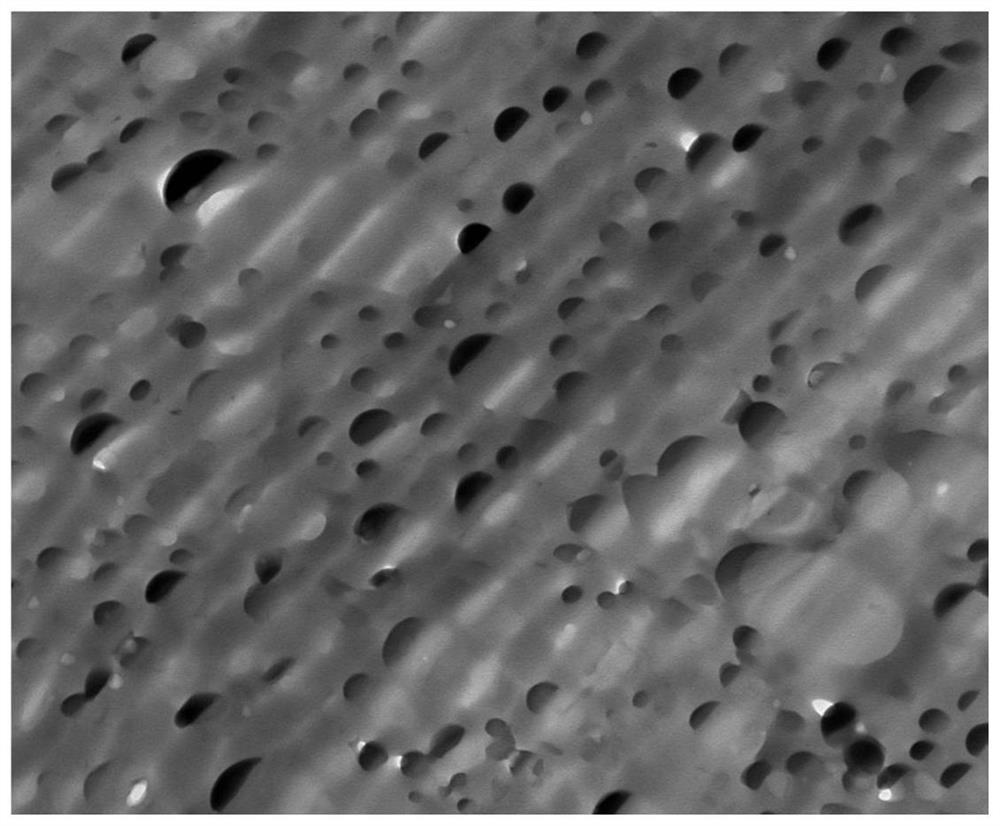A method for separating and obtaining recycled polyester from waste polyester raw materials
A technology of regenerated polyester and waste polyester, which is applied in the direction of plastic recycling and recycling technology, which can solve the problems of large foam particles and decreased depolymerization rate, achieve high specific surface area, increase yield, and accelerate depolymerization reaction speed effect
- Summary
- Abstract
- Description
- Claims
- Application Information
AI Technical Summary
Problems solved by technology
Method used
Image
Examples
Embodiment 1
[0047] After cleaning and drying the recycled and sorted polyester (PET) bottle flakes and polyester (PET) pulp blocks, they are melted and granulated in a twin-screw extruder. The heating temperature of each zone of the twin-screw extruder is 250°C, 260°C, 270°C, 280°C, 275°C, 275°C, 270°C, the feeding percentage of the screw is 15%, the rotation speed is 50rpm, the pressure is 3Mpa, micropores are formed The material chooses to add foaming agent AC, the mass ratio of foaming agent to waste polyester is 1:200, and the feeding position is the fourth heating zone of the screw. After the granulation is completed, the micropore formation is stable after passing through the cooling water tank.
[0048] The average cell diameter of the microporous waste polyester granules prepared by the microporous waste polyester granulation step is 85 μm, and the relative density is 0.35. For the average cell diameter test, the average value of 100 average cell diameters was continuously measure...
Embodiment 2
[0055] The recycled and sorted polyester (PET) film and polyester (PET) fiber products (curtains, carpets, clothing, etc.) are densified by thermal friction molding process at a temperature of 220°C, a pressure of 3MPa, and a time of 10 minutes. into foam. The foam is then melt-granulated in a twin-screw extruder. The heating temperature of each zone of the twin-screw extruder is 265°C, 270°C, 275°C, 280°C, 275°C, 270°C, 270°C, the feeding percentage of the screw is 30%, the screw speed is 65rpm, the pressure is 6Mpa, the micropore The foaming agent ABIN is selected as the forming material, and the mass ratio of foaming agent to waste polyester is 1:250, and the feeding method is mixed in the fourth heating zone of the screw.
[0056] The average cell diameter of the microporous waste polyester granules prepared by the microporous waste polyester granulation step is 82 μm, and the relative density is 0.55.
[0057] Put the waste polyester (PET) pellets containing micropores ...
Embodiment 3
[0063] After cleaning and drying the recycled and sorted polyester (PET) bottle flakes and polyester (PET) pulp blocks, they are melted and granulated in a twin-screw extruder. The heating temperature of each zone of the twin-screw extruder is 260°C, 270°C, 280°C, 285°C, 275°C, 270°C, 270°C, the percentage of screw feed is 45%, the speed is 45rpm, the pressure is 75Mpa, the screw feed The percentage is 45%, the screw speed is 65rpm, and the pressure is 8.5Mpa. The foaming agent DPT and foaming agent ADC are selected for the micropore formation, and the ratio is 1:1. The mass ratio of foaming agent to waste polyester is 1:500. The feeding method is mixed in the fourth heating zone of the screw, and the micropore formation is stable after the granulation is completed and passed through the cooling water tank.
[0064] The average cell diameter of the microporous waste polyester granules prepared by the microporous waste polyester granulation step is 75 μm, and the relative densi...
PUM
| Property | Measurement | Unit |
|---|---|---|
| melting point | aaaaa | aaaaa |
| melting point | aaaaa | aaaaa |
| melting point | aaaaa | aaaaa |
Abstract
Description
Claims
Application Information
 Login to View More
Login to View More - R&D
- Intellectual Property
- Life Sciences
- Materials
- Tech Scout
- Unparalleled Data Quality
- Higher Quality Content
- 60% Fewer Hallucinations
Browse by: Latest US Patents, China's latest patents, Technical Efficacy Thesaurus, Application Domain, Technology Topic, Popular Technical Reports.
© 2025 PatSnap. All rights reserved.Legal|Privacy policy|Modern Slavery Act Transparency Statement|Sitemap|About US| Contact US: help@patsnap.com

